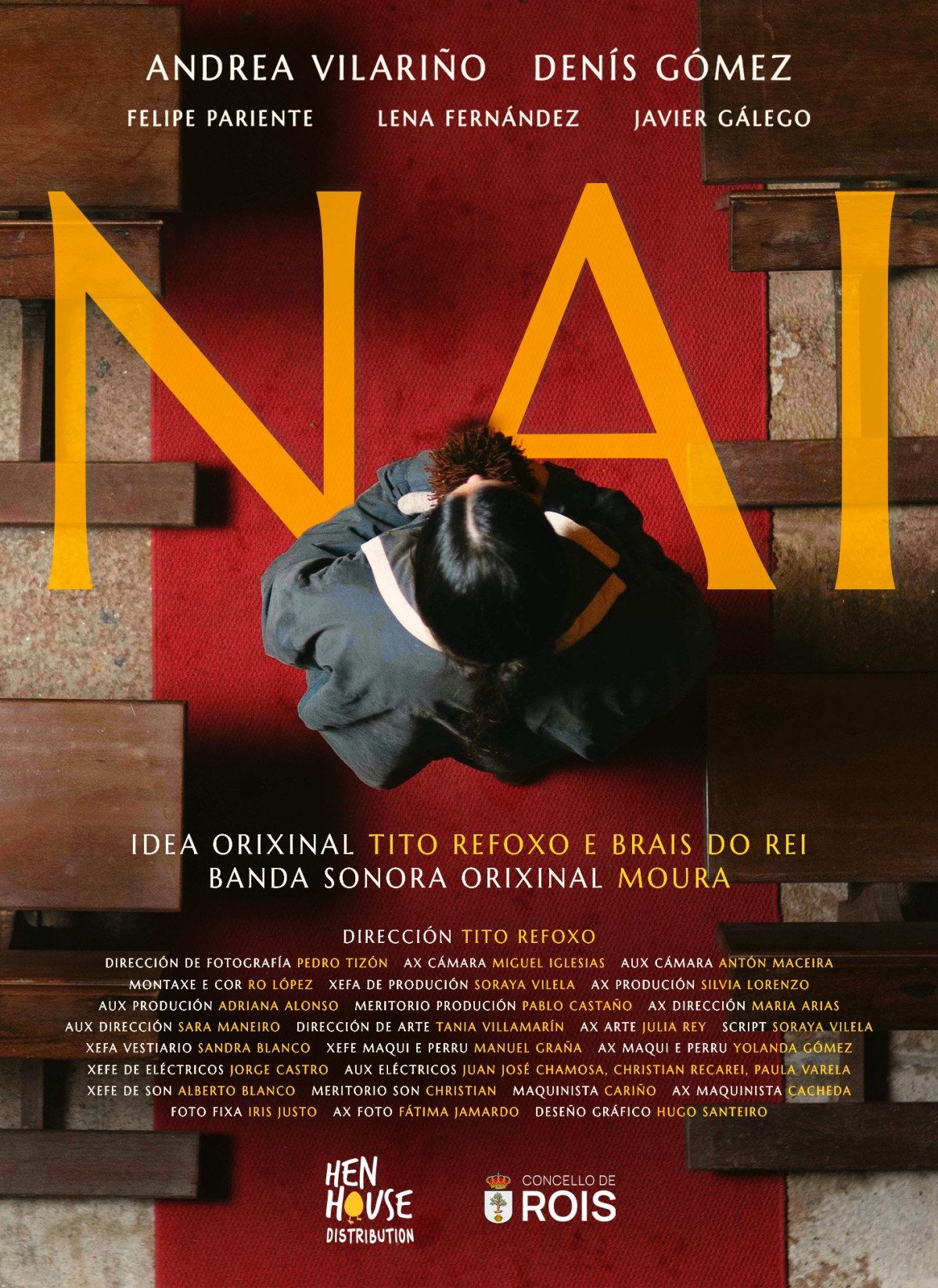La Danza Silenciosa en Oro y Ceniza
ART ESP / ING
El cartel de "Nai" se presenta como una pieza de intrigante belleza, una promesa visual que evoca una atmósfera cargada de misterio y una profunda conexión con lo ancestral. Su composición, dominada por una paleta cromática contrastada y una disposición de elementos deliberadamente simbólica, invita a una lectura que trasciende la mera información promocional.
El título, "NAI", se impone con una fuerza visual innegable. Las letras, de un dorado intenso que parece emanar luz propia, se recortan sobre un fondo de una tonalidad oscura y terrosa, casi cenicienta. Esta elección cromática no es casual; el oro, a menudo asociado con lo sagrado, lo eterno y lo valioso, contrasta poderosamente con la oscuridad, que puede sugerir lo oculto, lo desconocido o incluso la sombra de la memoria. La tipografía, de trazos firmes y elegantes, posee una cualidad atemporal, reforzando la sensación de un relato que podría trascender épocas.
En el corazón de la composición, una figura humana se presenta en una postura de recogimiento extremo. Inclinada hacia adelante, con la cabeza casi tocando el suelo, esta figura vestida de un tono que se funde con el fondo oscuro parece absorta en un silencio profundo, quizás en un acto de introspección, de lamento o de conexión con la tierra. La luz dorada del título parece envolverla sutilmente, sugiriendo una posible iluminación interior o una fuerza trascendente que la rodea.
La disposición de los nombres del equipo creativo en la parte superior e inferior del cartel se realiza con una sobriedad que no distrae del impacto visual central. La jerarquía visual está claramente definida, otorgando protagonismo al título y a la imagen central, elementos clave para despertar la curiosidad del espectador.
La idea original de Tito Refoxo y Brais do Rei, junto con la banda sonora original del propio Refoxo y Moura, se sitúan en un lugar destacado, sugiriendo que la música y la concepción narrativa son elementos fundamentales de la experiencia cinematográfica que el cartel anticipa.
En su conjunto, el cartel de "Nai" se aleja de la estridencia y el efectismo fácil. Opta por una estética más contemplativa y evocadora, sembrando preguntas en la mente del espectador. ¿Quién es esta figura? ¿Qué significado encierra ese gesto de profunda inclinación? ¿Qué historia se esconde tras el brillo dorado y la sombra terrosa?
Esta pieza gráfica demuestra una comprensión sofisticada del lenguaje visual cinematográfico. No se limita a anunciar una película; construye una atmósfera, sugiere un tono y plantea interrogantes que invitan al espectador a sumergirse en el universo de "Nai". Su fuerza reside en su capacidad para comunicar a través de la sugerencia, dejando espacio para la interpretación y despertando una profunda curiosidad por la narrativa que aguarda tras esta danza silenciosa en oro y ceniza.
-------------
The poster for "Nai" presents itself as a piece of intriguingly beauty, a visual promise that evokes an atmosphere laden with mystery and a profound connection to the ancestral. Its composition, dominated by a contrasting color palette and a deliberately symbolic arrangement of elements, invites a reading that transcends mere promotional information.
The title, "NAI," imposes itself with undeniable visual force. The letters, of an intense gold that seems to emanate its own light, are silhouetted against a background of a dark and earthy, almost ash-like tonality. This chromatic choice is not accidental; gold, often associated with the sacred, the eternal, and the valuable, contrasts powerfully with the darkness, which can suggest the hidden, the unknown, or even the shadow of memory. The typography, with firm and elegant strokes, possesses a timeless quality, reinforcing the feeling of a narrative that could transcend epochs.
At the heart of the composition, a human figure is presented in a posture of extreme withdrawal. Leaning forward, with their head almost touching the ground, this figure dressed in a tone that merges with the dark background appears absorbed in a profound silence, perhaps in an act of introspection, lament, or connection with the earth. The golden light of the title seems to subtly envelop them, suggesting a possible inner illumination or a transcendent force that surrounds them.
The arrangement of the names of the creative team at the top and bottom of the poster is done with a sobriety that does not distract from the central visual impact. The visual hierarchy is clearly defined, giving prominence to the title and the central image, key elements in arousing the viewer's curiosity.
The original idea by Tito Refoxo and Brais do Rei, along with the original soundtrack by Refoxo and Moura themselves, are placed prominently, suggesting that music and narrative conception are fundamental elements of the cinematic experience that the poster anticipates.
As a whole, the poster for "Nai" moves away from stridency and easy sensationalism. It opts for a more contemplative and evocative aesthetic, planting questions in the viewer's mind. Who is this figure? What meaning does this gesture of profound inclination hold? What story lies hidden behind the golden glow and the earthy shadow?
This graphic piece demonstrates a sophisticated understanding of cinematic visual language. It does not limit itself to announcing a film; it builds an atmosphere, suggests a tone, and raises questions that invite the viewer to immerse themselves in the universe of "Nai." Its strength lies in its ability to communicate through suggestion, leaving room for interpretation and arousing a deep curiosity for the narrative that awaits behind this silent dance in gold and ash.

